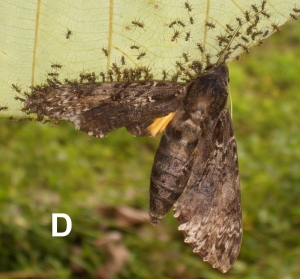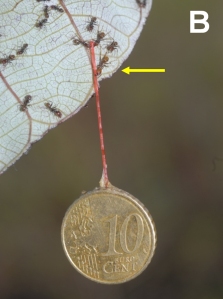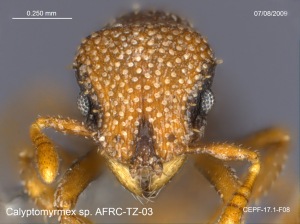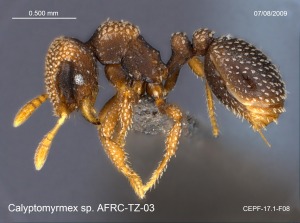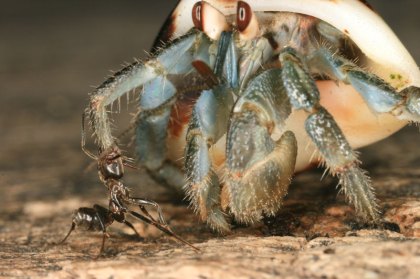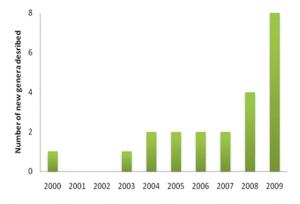Filed under: Database additions
Four months since I made the last update of the Ant Genera of the World website, and the less that can be told is that it has been a good time for the Ant Genera of the World database. 167 new records have been added concerning 87 genera! Almost a third of the known genera are concerned.
The new records allow to refine our predictions on the unknown distribution of some genera, and so the improvement of future predictions. As a result, 17 new interpolations have been added.
Most of the new records concern Honduras thanks to the work realized within the LLAMA project of Jack Longino, this year helped by Michael Branstetter who discovered two very interesting records among several others; Formica captured on the top of a mountain (this is the southern record of Formica for the New World); and the northern record for Paraponera (the bullet ant).
Lots of new data have been communicated to me for Brazil thanks to Rodrigo Feitosa who does an excellent job therel within the team of Roberto Brandao (who gave a very interesting talk at the IUSSI meeting). Thank you Rodrigo!
Other records came from various papers. One was especially important in this new update and focus on the ants of northern Mexico by Alatorre-Bracamontes and Vasquez-Bolano
During this period, at the beginning of August was the IUSSI meeting in Copenhagen. It was the occasion for me to present my work to many fellow myrmecologists, to see some friends and to develop new contacts. I had a fantastic time there and would like to thank all the people who visited my poster, and for their encouragements. It was great to hear about the website being useful and people to be eager to share new records! I am looking forward to see many of you and have more interesting discussions in the future.
At this point, this is my turn to share a few new records, but this time at a species level. I have found the rare and enigmatic Amblyopone trigognignatha (only collected one time in 1948 from one individual) two years ago during a photo session (confusing it with the more common A. pallipes), and recently the ant was identified from my pictures by Alex Wild. More info is available on this story is available on Myrmecos.net. This summer I also collected ants in different places of North Carolina in order to improve our knowledge on the myrmecofauna of this state. I am glad to announce that I have collected (yes, I collected it this time) what I have identified as Hypoponera inexorata! Finally, very recently, we did some collecting in South Carolina, and we captured Discothyrea testacea, a new record for the state (I had no records of this genus for SC in the database). I also suspect this species to be present in Virginia as I collected populous nests of this species only a few miles of the border of this state, but on the NC side. So if you go in Virginia, collect some leaf litter and you’ll have some good chance to find it!
So take your hand shovel and hang your Winkler bags!
Filed under: Uncategorized
Reading scientific articles is part of scientist every day job. I have to say that if I find that many papers can be classified as interesting for my research, but not necessarily exciting to read (even sometimes boring). The goal of a scientific article is not be exciting but to be useful, to make a point. Having undergraduate students working around, it is easy to tell that they are not extremely enthusiast about reading scientific articles in general. However, once in a while, some exciting papers are published that, I believe, will enthusiast most of their readers and could become one of those examples that professors can then use to explain a concept to their students. Students that could even enjoy them!
On arboreal ants, I can think about a few like this that came out over the past years such as the gliding Cephalotes and the red berry Cephalotes (infected by a nematode) of Steve Yanoviak, the devil gardens of Myrmelachista of Frederickson, or the trapping techniques of Allomerus by Dejean. In a new article, still by Dejean and collaborators published in PlosOne, ants reveal one more time some really cool example of adaptations to capture prey. Like the three previous examples, arboreal ants are involved. In this case, Azteca species use the structure of the leaves of their host plant to capture preys… huge preys! Up to 13000 times their own weight. And the authors to compare this with a 70 kg human being able to capture a 935 tons prey.
Wait a second, 935 tons… what could weight that much? That is about eight Boeings 757 full of passengers, or also the weight of a destroyer during the Second World War… Amazing!
The pictures provided in the article are great and talk for themselves. Also, do not miss the video in the supplement (it has the quality of a documentary).
Now the interest of the article is also to show that the relation between the plant species and the ant species is fundamental for the success of prey capture, as well as the side of the leaf used by ants to capture large sized prey. This provides a good example of the different benefits perceived by ants on different myrmecophytic plants.
Here is the link to the article:
http://www.plosone.org/article/info:doi/10.1371/journal.pone.0011331
Enjoy!
The last update of the ant generic database is only a month old, and I am glad to announce that no less than 110 additions/changes have been made since then.
Most of the modifications this time concerns regions of Asia and especially China where I have been able to find lots of new records for specific provinces. The difficulty I have since the beginning of this project for some regions like China has been to find and then understand the publications. Most of the work realized on Chinese ants has been published in Chinese journal which seems to have a limited distribution. The first difficulty has been to find the references of the different articles and then to obtain a copy of them. Hopefully for me, NCSU has an excellent library service! Thanks to them I have been able to have access to hundreds of articles and books which sometimes are mailed from the other side of the world just for my insatiable bulimia of data collection. The second difficulty is of course the reading. Reading Chinese is not an easy thing to do, especially when you don’t understand it, but fortunately, the format of scientific paper coupled with the access to Internet and tools of translation allow me to extract the information I need. At many occasions, I though about the perseverance of Champollion who pierced the secrets of Egyptian hieroglyphs on the Rosetta Stone.
Anyway, the maps have now 96 new records (green), 11 new interpolations (blue) and 3 new records for introduced genus (orange).
Besides China, a few records have been added for South East Asia, Central Asia, South America or Africa.
While most novelties are only novelties in a sense that I did not came across those references earlier, there is a real new one with the discovery of Asphinctopone by Peter Hawkes in Tanzania (published in Zootaxa). This new record extends the range of this Ponerine genus on the East coast of Africa and is also at the same time the southern record. Needless to say that this is a pretty cool new record!
I also found very interesting the position of Peter Hawkes who is the director of a company specialized in the monitoring of arthropods diversity in Africa, called Afribugs. I believe that it is during one of those monitoring, that Peter has discovered the new Asphinctopone species. On the website of Afribugs, you could learn about the company but also see some of the awesome specimens collected.
For instance, this nice species of Calyptomyrmex collected also in Tanzania. Take a look!
Filed under: Picture
Here is a picture that I took in Costa Rica (which survived my computer crash). You can see an Azteca worker attacking an hermit crab. The duel finished by the desertion of the hermit crab.
Long time without posting and many things to report.
As some of you might now, I spent the beginning of this year in Costa Rica and did a little excursion in Panama. Of course, I took a lot of pictures of ants and other invertebrates, plants, amphibians, lizards … but about 3 weeks ago my computer feel on the ground and since then I have not been able to get my pictures back, at least most of them (hard drive broken). I still have about 250 pictures left, but some series are entirely gone unfortunately.
Now that I started with the bad news, I can continue with the good news. Of course that trip was fantastic and the return was of course a little bit sad. Sometimes, you feel good somewhere and would like to stay longer, much longer…
During my trip at Barro Colorado Island (BCI), I had the chance to meet David Donoso, PhD student in Mike Kaspari’s laboratory. Of course, we talk about ants and David‘s work on BCI, where he is interested by the effect of specific tree presence on the structure of leaf litter ants. David is also interested to develop the knowledge and the taxonomy of ants from Ecuador, where David comes from, and at this effect, he orientates me to some of his work (published in a French journal!).
David also works on a revision of the very interesting genus Tatuidris (pictures on Antweb). It was the first time that I had the chance to see this beautiful ant under a microscope and they are totally amazing! David provided me some records that I did not know about Tatuidris, and so the new map is now updated!
Let’s continue with the new additions of the database, and let me thanks Dr. Mostafa Sharaf from Riyadh who provides me some of his articles and new discoveries about the ants of Egypt, Qatar and Saudi Arabia. Among the main additions, notice the presence of Carebara and Solenopsis in Saudi Arabia; the potential presence of Leptanilla in Egypt and Saudi Arabia, and the removal of Lasius from Egypt (probably a misidentification).
Also, note that in the last paper of Omid Paknia and collaborators published a new article on the ants of Iran in Asian Myrmecology. They provide new generic records for Dolichoderus, Myrmecina, Proformica, Pyramica, Stenamma and Strongylognathus, as well as a total of 32 new species records.
Here is an overview of the new records:
What have changed since the last major update (12th Decembre 2009):
– 59 new records representing 43 genera
– 10 new interpolations for 6 genera
– 6 records of genera that have been introduced in a region
– 5 records removed (misidentification in the original paper) for 2 genera (Lasius and Dicroaspis)
Note that the change of Paratrechina into Nylanderia, Paraparatrechina and Paratrechina is not yet effective on the maps.
Finally I would like to thank those of you who read this blog and communicate with me to improve the maps. It is always a pleasure, thank you!
Filed under: Thoughts
Blogging will take a break for the next two months for cause of travelling in Costa Rica and Panama.
I will be taking the OTS course in Tropical Ecology and will come back at the end of March.
Hopefully, I should be able to take a lot of ant pictures during my trip.
Before to leave, I have to fill a commitment.
In a previous blog, I said that if someone could give me 5 good reasons to like Paratrechina (now Nylanderia), I would write a poem. Well, James Trager gave me several reasons, and all good, so here is my poem.
I apologize for those of you that appreciate poetry in Shakespeare language, but I felt more comfortable to do so in Rabelais language (but the comparison stop here).
Nylanderia cours dans la litière du bois
Frénétiquement, à la recherche d’une proie
Les poils hirsutes et la cuticule brillante,
Les mandibules légèrement ballantes.
Qu’un cadavre frais d’insecte se présente
Et c’est une brève inspection qui commence.
Pas de temps à perdre, les antennes dansent
Avant la venue des autres dominantes.
Recruter, récolter sont les impératifs
Pour nourrir la colonie et ses œufs natifs.
Soudain les longues antennes goûtent l’air
D’une odeur ni amicale, ni familière.
A retraite honorable, suis un repas
Pour celles qu’on appelait Paratrechina.
Filed under: Database additions
Thanks to the fantastic work of my friend and colleague Neil McCoy, our website on Ant Genera of the World has now a brand new interface.
Neil already made the first design, but was not totally satisfied with it. So he decided to recreate the design of the website to something more interactive and more visual. I personally love the new website and hope that you will enjoy it as much as I do. Over the past months, Neil has also created the lab webpage for our lab (Rob Dunn’s lab website).
If you need to create a webpage or update your old one, don’t hesitate to contact Neil McCoy (mccoy.neil1@gmail.com) to prospect for possibilities.
We have also used this occasion to update the maps and include some of the new genera recently described over the past months, while we did not update the recent revision of Paratrechina (see previous post).
If you detect any bug on the website, please let us know to fix it.
Filed under: Database additions
I love ants, all of them. Even at a point, this always surprises my family that I find them very pretty. However, to all rules, there is an exception: the genus Paratrechina. For the species I encounter here in North Carolina, I can’t say that I could imagine myself study them for years (but probably if I tried, I would changed my mind). They are funny looking with their erected setae all along the body, but to me they all look the same, and when my colleagues ask me to check ant identification, I always expect that it is not a Paratrechina. They are my ID nightmare.
Well, thanks to an article published by LaPolla and collaborators in Systematic Entomology, it turns out that my nightmare might have tripled now (many thanks 😉 . The former Paratrechina genus is now split into Paratrechina sensu sricto, Nylanderia and Paraparatrechina. In this article, the authors explored the Prenolepis genus group (Euprenolepis, Nylanderia, Paraparatrechina, Paratrechina, Prenolepis and Pseudolasius) and found several interesting results. As just said, Paratrechina is now divided into 3 distinct genera. The Paratrechina genus is now represented only by the invasive Paratrechina longicornis. The native Paratrechina from North America for instance, now become Nylanderia (for example Nylanderia concinna, faisonensis, parvula, or vividula). Note that Nylanderia has a global distribution (but absent for high latitudes) So the revision of James Trager of Paratrechina in 1984, turn out to be now a revision of Nylanderia (with the exception of the part on Paratrechina longicornis ). The genus Paraparatrechina is mostly limited to the tropical regions of the old world (with the exceptions of south east Australia). See the maps in the article for the distribution of the different genera.
Here is the abstract of the article:
We investigated the phylogeny and taxonomy of the Prenolepis genusgroup, a clade of ants we define within the subfamily Formicinae comprising the genera Euprenolepis, Nylanderia, gen. rev., Paraparatrechina, gen. rev. & stat. nov., Paratrechina, Prenolepis and Pseudolasius. We inferred a phylogeny of the Prenolepis genus-group using DNA sequence data from five genes (CAD, EF1αF1, EF1αF2, wingless and COI) sampled from 50 taxa. Based on the results of this phylogeny the taxonomy of the Prenolepis genus-group was re-examined. Paratrechina (broad sense) species segregated into three distinct, robust clades. Paratrechina longicornis represents a distinct lineage, a result consistent with morphological evidence; because this is the type species for the genus, Paratrechina is redefined as a monotypic genus. Two formerly synonymized subgenera, Nylanderia and Paraparatrechina, are raised to generic status in order to provide names for the other two clades. The majority of taxa formerly placed in Paratrechina, 133 species and subspecies, are transferred to Nylanderia, and 28 species and subspecies are transferred to Paraparatrechina. In addition, two species are transferred from Pseudolasius to Paraparatrechina and one species of Pseudolasius is transferred to Nylanderia. A morphological diagnosis for the worker caste of all six genera is provided, with a discussion of the morphological characters used to define each genus. Two genera, Prenolepis and Pseudolasius, were not recovered as monophyletic by the molecular data, and the implications of this result are discussed. A worker-based key to the genera of the Prenolepis genus-group is provided.
Finally, note that with the descriptions of those two new genera, my list of extant genera now reach the symbolic number of 300! That’s a good way to start 2010.
Alright, I have some new maps to update now!
PS: If you can give me 5 good reasons to love Paratrechina/Nylanderia/Paraparatrechina, I promise to try to write a poem to celebrate them (in French or in English).
References:
LaPolla J.S., S.G. Brady, and S.O. Shattuck. 2010. Phylogeny and taxonomy of the Prenolepis genus-group of ants (Hymenoptera: Formicidae). Systematic Entomology 35: 118-131.
Trager J.C. A revision of the genus Paratrechina of the continental United States. Sociobiology 9: 51-162.
Filed under: Uncategorized
This is the first post for this new Year 2010, so let’s go back in the past, you know those old time of 2009, or even 2008. But first of all, I wish you an excellent new year, with I hope tons of discoveries and exciting ant projects .
Recapitulate what happens in 2009 for ant genera discoveries.
As we say for wine, 2008 was a “grand cru”, well 2009 was a “cru exceptionnel”!
For those of you who are also wine lovers, you might have heard that the wine production last year in France is supposed to be exceptional (un cru exeptionnel in French)!
Well, 2009 was not only a great year for French wine bottles but also for ant new genera descriptions!
The graphic below represents the number of new genera described each year from 2000 to 2009 (2009 should have 9 genera and not 8).
From 2000 to 2007, about zero to two new genera maximum per year have been described. And then, we had a first burst in 2008 with 4 new genera (including one new sub-family, Martialinae)! But that’s nothing beside the big bang of 2009 and its 9 new genera. So what is happening and who are the newbie’s and the resurrected genera?
Well, first it seems that a new prolific and very nice generation of new myrmecologists is arriving and they are eager to let their mark in myrmecology, while at the same time some more established myrmecologists have continued their great work.
The year 2008 saw the arrival of Feroponera and Promyopias Bolton & Fisher in Africa (the later been resurrected);Opamyrma Yamane et al. in Vietnam; and the new subfamily Martialinae and genus Martialis Rabeling et al. from Brazil.
The year 2009 has Kalathomyrmex and Paramycetophylax Klingerberg & Brandao from South America (the later been resurrected); Tropidomyrmex Silva et al. (2009) also from South America; Aptinoma and Ravavy Fisher (2009) from Madagascar; Austromorium Shattuck from Australia; Diaphoromyrma Fernandez et al. from Bahia (Brazil ); andPropodilobus Branstetter from Borneo.
Finally, I just found out yesterday the description of a new genus from Taiwan (or I should say from an island just beside Taiwan) by M. Terayama and called Formosimyrma (Myrmicinae).
So the total for 2009 is 7 new Myrmicine genera and 2 new Dolichoderine genera.
So 9 new genera descriptions to beat in 2010. It seems that this new year is starting well with the split of Paratrechinainto 3 genera: Paratrechina, Parapatrechina and Nylanderia (see next post) by LaPolla and collaborators.
So as a summary for 2009:
– Most genera described were Myrmicinae (7/9).
– South America (4/9), Asia (2/9), Madagascar (2/9) and Australia (1/9) are the regions that contributed to new ant genera description.
– The journal Zootaxa has become the main journal for generic description/revision of ant taxa (8 genera on 9 described in this journal)
Some of those changes are already online on Ant Genera of the World, and the rest will come with very soon (with the next big update of our website in the coming weeks)
References:
Bolton B., and B.L. Fisher . 2008. Afrotropical ants of the ponerine genera Centromyrmex Mayr, Promyopias Santschi gen. rev. and Feroponera gen. n., with a revised key to genera of African Ponerinae (Hymenoptera: Formicidae).Zootaxa 1929: 1-37.
Branstetter M.G. 2009. The ant genus Stenamma Westwood (Hymenoptera: Formicidae) redefined, witha description of a new genus Propodilobus. Zootaxa 2221: 41-57.
Fernandez F., J.H.C. Delabie, and I.C. do Nascimento. 2009. Diaphoromyrma, a new myrmicine ant genus (Hymenoptera: Formicidae) from North Eastern Brazil. Zootaxa 2204: 55-62.
Fisher B.L. 2009. Two new dolichoderine ant genera from Madagascar: Aptinoma gen. n. and Ravavy gen. n. (Hymenoptera: Formicidae). Zootaxa 2118: 37-52.
Klingenberg C., and C.R.F. Brandao. 2009. Revision of the fungus-growing ant genera Mycetophylax Emery and Paramycetophylax Kusnezov rev. stat., and description of Kalathomyrmex n. gen. (Formicidae: Myrmicinae: Attini). Zootaxa 2052: 1-31.
LaPolla J.S., S.G. Brady, and S.O. Shattuck. 2010. Phylogeny and taxonomy of the Prenolepis genus-group of ants (Hymenoptera: Formicidae). Systematic Entomology 35: 118-131.
Rabeling C., J.M. Brown, and M. Verhaagh. 2008. Newly discovered sister lineage sheds lighton early ant evolution.PNAS 105 (39): 14913-14917.
Shattuck S.O. Austromorium, a new myrmicine ant genus from Australia (Hymenoptera: Formicidae). Zootaxa 2193: 62-68.
Silva R.R., R.M. Feitosa, C.R.F. Brandao, and J.L.M. Diniz. 2009. Tropidomyrmex elianae, a new myrmicine ant genus and species from Brazil, tentatively assigned to Solenopsidini (Hymenoptera, Formicidae). Zootaxa 2052: 32-48.
Terayama M. 2009. A synopsis of the family Formicidae of Taiwan (Insecta; Hymenoptera). The Research Bulletin of Kanto Gakuen University 17: 81-266.
Yamane S., T.V. Bui, and K. Eguchi. 2008. Opamyrma hungvuong, a new genus and species of ant related toApomyrma (Hymenoptera: Formicidae: Amblyoponinae). Zootaxa 1767: 55-63.
Despite the busy schedule of the past two months (see previous post), I have been able to find some new records and filled a few gaps. Here is a summary of the new modifications realized on the maps (and so in the database):
A total of 86 new records (green), 9 interpolations (blue), 2 exotic presence (orange) and one removal have been included.
Most of the new records are scattered around the globe, and for their majority turned out to be confirmation of our interpolations (blue on the maps). Two regions in particular have been improved. Tthe first one is Acre in Brazil (+32 new records; + 1 exotic) which has been covered those past years by Dr. Marco Antonio de Oliveira during his PhD.
The second main addition is for Pennsylvania (USA) which curiously despite his big size and large human population did not seemed to have been covered by myrmecologists pretty well in the past. Antweb now offers a list of ants for this state compiled by W. Barkley Butler (+7 new generic records).
A revision of the oriental Anillomyrma in the online earlier of Myrmecological News by Katsuyuki Eguchi, Tuan Viet Bui, David M. General, and Gary D. Alpert provides a new record for the Philippines, and the removal of this genus from Madagascar. Some incertitudes about the potential presence of this genus in Africa remains with a potential record from Tanzania by Dr. Hamish Robertson. However the authors could not have confirmation from Dr. Robertson (and neither do I). If anyone has some information about it, please let me know.
Finally, an interesting new record of the Neotropical genus Gracilidris has been brought to me by Alex Wild (see his excellent blog Myrmecos). A new record is available on Antweb for Colombia. This record represents the western and northern record for the genus and is disjunct with the rest of the range distribution which could be qualified as east-central South America.
I also want to thank Dr. Martin Bollazzi for some of the new records he provides me for Uruguay.
If some of you, dear readers has new data, as always, do not hesitate to contact me. Everybody will benefit from new additions and accurate maps.
